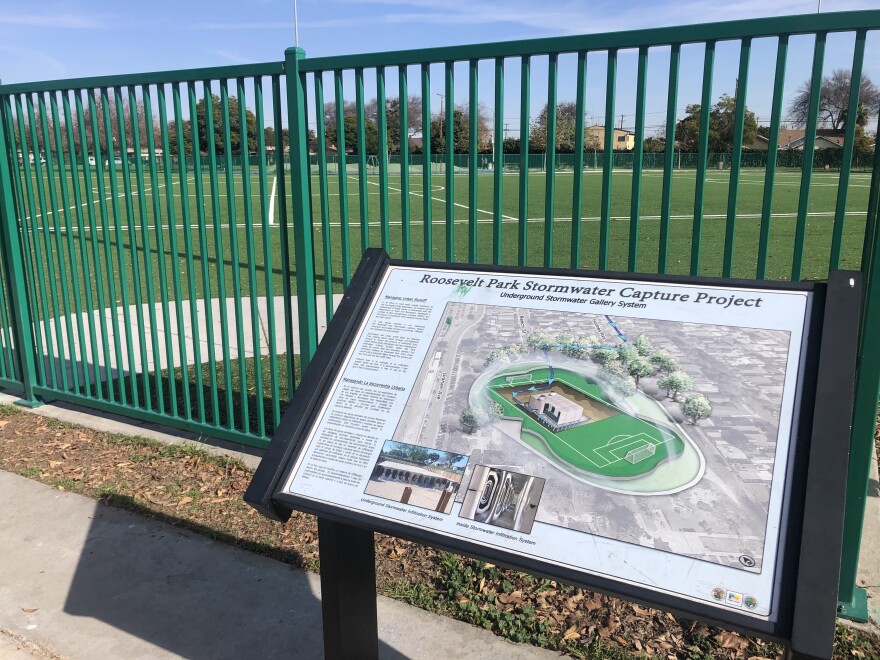The recent storms have helped a lot to face water scarcity, but it’s not enough to end three years of historic drought. And as the climate crisis makes California’s drought-to-deluge cycles more extreme and less predictable, capturing rainfall when it comes will be a necessity.
In recent storms, L.A. County said it captured some 33 billion gallons of water, enough to support about 800,000 households for a whole year. Most of that water was caught in dams in the San Gabriel Mountains, according to Steve Frasher, public information officer with L.A. County Public Works. But dozens of smaller projects across the county will help add to that—and can improve park space along the way.
-
After three years of severe drought, the last few weeks of rain have felt… weird. According to experts, this winter so far has actually been what might be considered normal for California, a state where "normal is abnormal" and that for millennia has rotated between drought and deluge. But the climate crisis is making wet periods like we just had less predictable and more extreme, while making dry periods longer and drier.
-
Here in the greater L.A. region, the climate crisis isn’t expected to change the total average amount of rainfall much from decades prior to 2000, according to a 2015 study from UCLA. But that doesn’t mean we’re out of the woods—according to that same study, the climate crisis will make rainfall in the coming decades much less frequent, and far more intense when it does come. Those types of massive storms will be tough for aging infrastructure to manage, and presents dangerous flooding and mudslide potential—especially as fires get worse.
-
That’s why the state, the city of L.A., L.A. County. and other Southland governments are investing in large and small efforts to improve stormwater capture infrastructure. And as the Southland’s traditional sources of water—snowpack from the Sierra Nevadas and the Rocky Mountains—dwindle with global heating, catching stormwater at a local level is an important piece of the climate adaptation puzzle.
One example is Franklin D. Roosevelt park in the Florence neighborhood of South L.A., where there’s a hidden system that caught 1.5 million gallons of water in the recent storms.
Instead of the neighborhood’s storm drains rushing water to Compton Creek then the L.A. River then to the ocean, the drains have been redirected to a filtration system built underneath a new turf soccer field and renovated skate park.
From there, the water slowly percolates into an underground aquifer that’s tapped for drinking water.
-
By late January, L.A. County captured some 33 billion gallons of water, enough to support about 800,000 households for a whole year. Most of that water was caught in dams in the San Gabriel Mountains, according to Steve Frasher, a public information officer with L.A. County Public Works.
-
The city of L.A. announced in a press release that it's caught more than 10.6 billion gallons of water, enough for about 139,000 households for a year.
-
For comparison, the water use in the city of L.A. totals about 168 billion gallons per year.
“Here we're doing stormwater capture and helping revitalize the play structures and the play fields for the neighborhood at the same time,” Frasher said.
Neighborhood-level projects like this one don’t have to be just about water supply. Funds for stormwater capture can lead to park and green space improvements in neighborhoods that have long been overburdened by industry and pollution—like much of the south part of the county.
On a recent afternoon, the park was full of elders playing board games, parents with their young children on the playground, and kids listening to music and skateboarding.
Aria Hendricks grew up in Bell Gardens and has long come to Franklin D. Roosevelt Park. He’s noticed the change.
-
Nonprofit's launching fundraiser to keep it afloat
-
USC study documents what residents want from trees
-
What candidates can — and can't — say they do
“It used to be pretty bad,” he said. “There’s people running around—there were not people running before. It’s nice over here. It’s definitely a lot different.”
The funds for the stormwater capture system also allowed the county to revamp the park with a new turf soccer field, outdoor exercise equipment, upgraded playgrounds, and a renovated skate park.
-
Stormwater capture doesn't only have to happen in massive systems like dams and spreading grounds or even parks and street medians. You can also capture stormwater at home — and get around those drought restrictions.
-
The L.A. Department of Water and Power has rebates that range from up to $50 for rain barrels that hold at least 50 gallons of water, and from $300 to $500 for cisterns ranging in size from 200 to over 1,000 gallons. Visit LADWP.com/save to learn more.
-
Check with your local water provider to see if they also provide rebates for rain barrels.
In a process starting in 2017, the county worked with local community members and community-based groups to create a park the community wanted and was involved in developing. It was completed in 2020.
Frasher said that currently, stormwater provides about 30% of the county’s drinking water on average. The goal is to get that number to 70%. That’ll require massive infrastructure upgrades, including cleaning up groundwater basins to store captured water as well as building out smaller projects like this one.
But it’ll happen drop by drop—officials estimate the county’s plans could take 50 years to fully complete.










